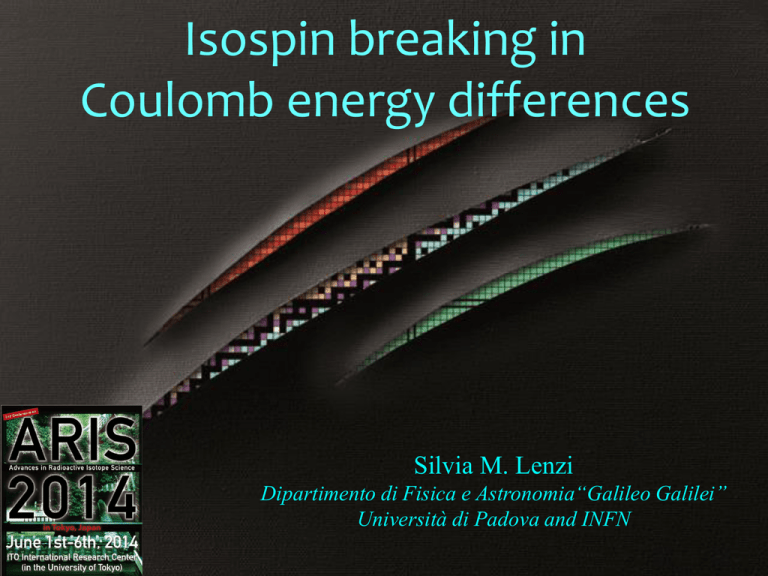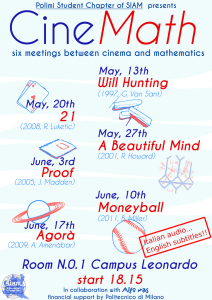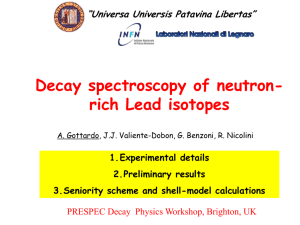Isospin Symmetry Breaking in Coulomb Energy Differences
advertisement

Isospin breaking in Coulomb energy differences Mirror Symmetry Silvia M. Lenzi Dipartimento di Fisica e Astronomia“Galileo Galilei” Università di Padova and INFN Silvia Lenzi University of– ARIS Padova and INFN Silvia Lenzi 2014, Tokyo, June 2-6, 2014 Neutron-proton exchange symmetry Charge symmetry : Vpp = Vnn Charge independence: (Vpp + Vnn)/2= Vnp Deviations are small MeV 5 T=0 and T=1 T=1 4 MeV T=1 5 4 4+ 4+ 4+ 1 2+ 2+ 2+ 0 0+ 0.693 1+ 0+ 0+0 3 2 3 2 22 12 Mg 10 3+ 22 11Na11 22 10Ne12 Silvia Lenzi – ARIS 2014, Tokyo, June 2-6, 2014 1 Differences in analogue excited states Z Mirror Energy Differences (MED) N MED J ExJ ,Tz T ExJ ,Tz T Test the charge symmetry of the interaction Triplet Energy Differences (TED) TED J ExJ ,Tz T ExJ ,Tz T 2 ExJ ,Tz 0 Test the charge independency of the interaction Silvia Lenzi – ARIS 2014, Tokyo, June 2-6, 2014 Mirror symmetry is (slightly) broken Isospin symmetry breakdown, mainly due to the Coulomb field, manifests when comparing mirror nuclei. This constitutes an efficient observatory for a direct insight into nuclear structure Silvia Lenzi – ARIS 2014, Tokyo, Juneproperties. 2-6, 2014 Measuring MED and TED Can we reproduce such small energy differences? What can we learn from them? They contain a richness of information about spin-dependent structural phenomena We measure nuclear structure features: How the nucleus generates its angular momentum Evolution of radii (deformation) along a rotational band Learn about the configuration of the states Isospin non-conserving terms of the interaction Silvia Lenzi – ARIS 2014, Tokyo, June 2-6, 2014 Coulomb effects VC VCM VCm VCM Multipole Coulomb energy: Between valence protons only 3 e 2 Z ( Z 1) ECr 5 R VCm Monopole Coulomb energy radial effect: radius changes with J L2 term to account for shell effects ECll 4.5Z cs13 /12 [2l (l 1) N ( N 3)] keV A1/ 3 ( N 3 / 2) electromagnetic LS term ECls ( g s gl ) 1 1 dVC l.s 2 2 4mN c r dr Silvia Lenzi – ARIS 2014, Tokyo, June 2-6, 2014 change the single-particle energies Are Coulomb corrections enough? 49 25 VCM+VCm Mn24 49 24 Cr25 VCM Exp VCm Another isospin symmetry breaking (ISB) term is needed and it has to be big! Silvia Lenzi – ARIS 2014, Tokyo, June 2-6, 2014 Looking for an empirical interaction In the single f7/2 shell, an interaction V can be defined by two-body matrix elements written in the proton-neutron formalism : V , V , V We can recast them in terms of isoscalar, isovector and isotensor contributions ππ πν νν U (0) V V V U (1) V V U (2) V V 2V Mirrors Triplet ) (1) MEDJ (42 Ti-42We Ca)assume U (f17)/ 2 , J that VC(1the V configurations ,J B, J Isovector of these states are pure (f7/2)2 TEDJ (42 Ti42 Ca - 242 Sc ) U (f72/)2 , J VC(,2J) VB(,2J) Isotensor Silvia Lenzi – ARIS 2014, Tokyo, June 2-6, 2014 Looking for an empirical interaction From the yrast spectra of the T=1 triplet 42Ti, 42Sc, 42Ca we deduce the interaction J=0 J=2 J=4 J=6 81 24 6 -11 MED-VC 5 93 5 -48 TED-VC 117 81 3 -42 VC Calculated estimate VB (1) estimate VB (2) Simple ansatz for the application to nuclei in the pf shell: (1) VBpf ( ( f 72/ 2 ) J 2 ) 100 keV (2) VBpf ( ( f 72/ 2 ) J 0 ) 100 keV J=2 anomally A. P. Zuker et al., PRL 89, 142502 (2002) Silvia Lenzi – ARIS 2014, Tokyo, June 2-6, 2014 The “J=2 anomaly” Coulomb matrix elements (MeV) Is this just a Coulomb two-body effect? Spatial correlation probability for two nucleons in f7/2 Calculation (using Harmonic Oscillator w.f) Two possibilities: 1) Increase the J=2 term 2) Decrease the J=0 term We choose 1) but there is not much difference Angular momentum J Silvia Lenzi – ARIS 2014, Tokyo, June 2-6, 2014 Calculating MED and TED We rely on isospin-conserving shell model wave functions and obtain the energy differences in first order perturbation theory as sum of expectation values of the Coulomb (VC) and isospin-breaking (VB) interactions MED exp J E Z E Z * J * J (1) MED theo V V V J M Cm J M CM J M B J * * * TED exp E Z E Z 2 E J J J J N Z (2) TED theo V V J T CM J T B J Silvia Lenzi – ARIS 2014, Tokyo, June 2-6, 2014 Calculating the MED with SM MEDJtheo M VCm J M VCM J M VB(1) J Theo VCM: gives information on the nucleon alignment or recoupling 49Mn-49Cr VCM Exp VCm: gives information on changes in the nuclear radius VCm Important contribution from the ISB VB term: of the same order as the Coulomb contributions M.A. Bentley and SML, Prog. Part. Nucl. Phys. 59, 497-561 (2007) VB A. P. Zuker et al., PRL 89, 142502 (2002) Silvia Lenzi – ARIS 2014, Tokyo, June 2-6, 2014 MED in T=1/2 states Very good quantitative description of data without free parameters A = 45 V22 4522T i23 45 23 A = 47 A = 49 A = 51 51 26 49 25 47 24 Cr23 4723V24 Mn24 49 24 Cr25 51 Fe25 25 Mn26 53 27 A = 53 M.A. Bentley and SML, Prog. Part. Nucl. Phys. 59, 497-561 (2007) Silvia Lenzi – ARIS 2014, Tokyo, June 2-6, 2014 53 Co 26 26 Fe27 MED in T=1 states A = 42 T i20 42 20 Ca 22 42 22 A = 46 A = 48 50 26 48 25 46 24 Cr22 4622T i24 Mn23 4823V25 Fe24 50 24 Cr26 A = 50 140 120 A = 54 100 M.A. Bentley and SML, Prog. Part. Nucl. Phys. 59, 497-561 (2007) Same parameterization for the whole f7/2 shell! 54 28 Ni26 54 26 Fe28 80 60 40 20 0 -20 -40 0 Silvia Lenzi – ARIS 2014, Tokyo, June 2-6, 2014 2 4 6 TED (keV) TED (keV) TED (keV) TED (keV) TED in the f7/2shell Only multipole effects are relevant. The ISB term VB is of the same magnitude of the Multipole Coulomb term Silvia Lenzi – ARIS 2014, Tokyo, June 2-6, 2014 Some questions arise… What happens farther from stability or at larger T in the f7/2 shell? The same prescription applies (poster by T. Henry) Can we understand the origin of this term? Work in progress Is the ISB term confined to the f7/2 shell or is a general feature? If so the same prescription should work! Silvia Lenzi – ARIS 2014, Tokyo, June 2-6, 2014 Looking for a systematic ISB term Necessary conditions for such studies: • good and enough available data • good shell model description of the structure Ideal case: the sd shell But…few data at high spin and no indications of “J=2 anomaly” in A=18 17 Silvia Lenzi – ARIS 2014, Tokyo, June 2-6, 2014 A systematic analysis of MED and TED in the sd shell Silvia Lenzi – ARIS 2014, Tokyo, June 2-6, 2014 18 The method We apply the same method as in the f7/2 shell However, here the three orbitals, d5/2, s1/2 and d3/2 play an important role MEDJtheo M VCr ll ls J M VCM J M VB(1) J VCr (radial term): looks at changes in occupation of the s1/2 (1) VBpf ( ( d 52/ 2 ) J 2 , ( d 32/ 2 ) J 2 ) 100 keV TEDJTheo T VCM J T VB( 2 ) J (2) VBpf ( ( d 52/ 2 ) J 0 , ( d 32/ 2 ) J 0 , ( s12/ 2 ) J 0 ) 100 keV Silvia Lenzi – ARIS 2014, Tokyo, June 2-6, 2014 MED: different contributions A=29 T=1/2 T=1/2 A=26 T=1 Silvia Lenzi – ARIS 2014, Tokyo, June 2-6, 2014 MED (keV) MED in the sd shell Silvia Lenzi – ARIS 2014, Tokyo, June 2-6, 2014 TED (keV) TED in the sd shell The prescription applies successfully also in the sd shell! Silvia Lenzi – ARIS 2014, Tokyo, June 2-6, 2014 MED and TED in the upper pf shell Silvia Lenzi – ARIS 2014, Tokyo, June 2-6, 2014 23 The method We apply the same method as in the f7/2 shell However, here the three orbitals, p3/2, f5/2 and p1/2 play an important role MEDJtheo M VCr ll ls J M VCM J M VB(1) J VCr (radial term): looks at changes in occupation of both p orbits (1) VBpf ( ( f 72/ 2 , p 32/ 2 , p12/ 2 , f 52/ 2 ) J 0 ) 100 keV TEDJTheo T VCM J T VB( 2 ) J (2) VBpf ( ( f 72/ 2 , p 32/ 2 , p12/ 2 , f 52/ 2 ) J 0 ) 100 keV Silvia Lenzi – ARIS 2014, Tokyo, June 2-6, 2014 MED (keV) MED in the upper pf shell Silvia Lenzi – ARIS 2014, Tokyo, June 2-6, 2014 TED in the upper pf and fpg shells TEDJTheo T VCM J T VB( 2 ) J (2) (2) ( ( p 32/ 2 , f 52/ 2 , p12/ 2 , g 92/ 2 ) J 0 ) 100 keV VBpf ( ( f 72/ 2 , p 32/ 2 , f 52/ 2 , p12/ 2 ) J 0 ) 100 keV VBfpg Silvia Lenzi – ARIS 2014, Tokyo, June 2-6, 2014 N~Z nuclei in the A~68-84 region Around N=Z quadrupole correlations are dominant. Prolate and oblate shapes coexist. The fpg space is not able to reproduce this behaviour, the fpgds space is needed. s1/2 d5/2 g9/2 f5/2 p quasi SU3 40 pseudo SU3 MED are sensitive to shape changes and therefore a full calculation is needed, which is not always achievable with large scale SM calculations A.P. Zuker, A. Poves, F. Nowacki and SML, arXiv:1404.0224 Experimentally may be not clear if what we measure are energy differences between analogue states, as ISB effects may exchange the order of nearby states of the same J Silvia Lenzi – ARIS 2014, Tokyo, June 2-6, 2014 Conclusions Z Proton-rich N~Z nuclei present several interesting properties and phenomena that can give information on specific terms of the nuclear interaction. N The investigation of MED and TED allows to have an insight on nuclear structural properties and their evolution as a function of angular momentum such as: alignments, changes of deformation, particular s.p. configurations. The need of including an additional ISB term VB in MED and TED shows up all along the N=Z line from the sd to the upper fp shell, therefore revealing as a general feature. Silvia Lenzi – ARIS 2014, Tokyo, June 2-6, 2014 In collaboration with Mike Bentley Rita Lau Andres Zuker Silvia Lenzi – ARIS 2014, Tokyo, June 2-6, 2014

